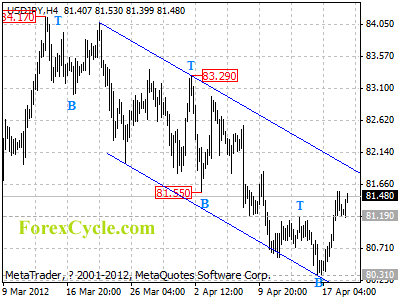London Gold Market Report
from Adrian Ash
BullionVault
Thurs 19 April, 08:55 EST
U.S.DOLLAR PRICES to buy gold slipped to two-week lows in London’s wholesale trade on Thursday, “falling victim to a strengthening Dollar” as one analyst put it while stock markets and commodities also gave back earlier gains.
The European single currency failed to hold above $1.3150 for the 3rd day running, dropping despite Madrid successfully auctioning some €5 billion in new Spanish debt.
Prices to buy gold were little changed for Euro investors, holding flat for the day at €41,180 per kilo, despite falling $10 per ounce to $1634 against the Dollar.
“The upside is very heavy because the Euro remains under pressure [vs. the Dollar],” Reuters today quoted Peter Fung at Wing Fung Precious Metals in Hong Kong.
“Weak physical demand isn’t helping,” he added, saying that a price-drop to $1600 would likely encourage traders to buy gold.
“Physical buying out of Asia is strengthening as we approach the Indian Akshaya Tritiya festival beginning 24 April,” says Marc Ground at Standard Bank today. But “the pace of demand is not to the extent that we expected.”
“No imports of gold have taken place in the last week,” said Bachhraj Bamalwa, chairman of the All India Gem & Jewellery Trade Federation, to the Economic Times earlier.
“Demand is lacklustre and there will be hardly any growth in the Akshaya Tritiya period this year.”
Considered an auspicious day on the Hindu calendar to buy gold and begin new ventures, Akshaya Tritiya this year sees the Indian Post Office working with the World Gold Council and Reliance Money to offer 6% discounts on gold coins sold through India Post branches.
“The Rupee is weaker than Dollar, which is pushing up prices to buy gold,” says a private broker.
“There is an increasing demand for diamonds as it is better preferred by the youngsters,” says one jeweler in Hyderabad, speaking to IBN Live.
Over in China, the world’s #2 consumer-gold market behind India – and where economic growth slowed for the 5th quarter running between Jan. and March – “The central bank will continue to implement a prudent monetary policy,” said a Chinese official to the Xinhua news agency today, “to facilitate a stable and relatively rapid development of the national economy.”
Japan is “fully committed [to] powerful monetary easing” said Tokyo’s chief central banker Masaaki Shirakawa late Wednesday.
Mark Carney, governor of the Bank of Canada, followed Tuesday’s no-change decision on monetary policy by telling a press conference yesterday that 1% interest rates are “consistent” with hitting the Bank’s 2% annual inflation target, with economic growth forecast at 2.4% in both 2012 and 2013.
“The most sensible thing to do is to take the cheap (free) money and convert it into solid things, like, for example, industrial metals,” says an editorial on global monetary policy in Metal Bulletin today.
“That’s why the warehouses are full, and why the prices remain firm.”
Latest data from the Comex US futures exchange showed a small decrease Wednesday in warehouse stockpiles of silver bullion, but this week’s 20-year record “certainly points to plentiful supply on the global silver market,” notes Swiss refining and finance group MKS.
“[It’s] very likely to block any major price increases in the short-term.”
Gold price chart, no delay | Buy gold online at live prices
Adrian Ash is head of research at BullionVault, the secure, low-cost gold and silver market for private investors online, where you can buy gold today vaulted in Zurich on $3 spreads and 0.8% dealing fees.
(c) BullionVault 2012
Please Note: This article is to inform your thinking, not lead it. Only you can decide the best place for your money, and any decision you make will put your money at risk. Information or data included here may have already been overtaken by events – and must be verified elsewhere – should you choose to act on it.
 Tradervox (Dublin) – The Swiss government has endorsed the Swiss National Bank Interim Chairman Thomas Jordan as the new SNB president. This announcement was given yesterday after the policy makers met to discuss the issue. The Swiss franc fell against the euro after this announcement. The decision by the Swiss policy makers has eased concerns that the SNB president would abandon the 1.20 limit cap policy that Jordan has pledged to stick with. Jordan is seen by the market as a proponent for the policy and he has indicated he is willing to do anything to protect the cap.
Tradervox (Dublin) – The Swiss government has endorsed the Swiss National Bank Interim Chairman Thomas Jordan as the new SNB president. This announcement was given yesterday after the policy makers met to discuss the issue. The Swiss franc fell against the euro after this announcement. The decision by the Swiss policy makers has eased concerns that the SNB president would abandon the 1.20 limit cap policy that Jordan has pledged to stick with. Jordan is seen by the market as a proponent for the policy and he has indicated he is willing to do anything to protect the cap.




